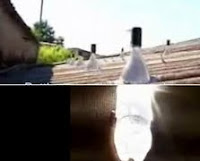http://www.coolbuster.net/2011/04/how-to-make-solar-bottle-bulb.html
How to make a Solar Bottle Bulb
By now you must have heard about “Isang Litrong Liwanag (A Liter of Light)”, a sustainable lightingproject of the MyShelter Foundation, established by business entrepreneur Illac Diaz, which aims to bring the eco-friendly Solar Bottle Bulb to disprivileged communities across the country.
 Designed and developed by students from the Massachusetts Institute of Technology (MIT), the Solar Bottle Bulb is based on the principles of Appropriate Technologies – a concept that provides simple and easily replicable technologies that address basic needs in developing communities.
Designed and developed by students from the Massachusetts Institute of Technology (MIT), the Solar Bottle Bulb is based on the principles of Appropriate Technologies – a concept that provides simple and easily replicable technologies that address basic needs in developing communities.
Poverty-stricken communities in Metro Manila like the Baseco Compound in Tondo have already started to utilize the cheap, solar-powered bulbs to light their homes.
Watch the following video to see how the people of Tondo benefit from the Solar Bottle Bulb, which only costs P100 to P200 to make.
If you want to have your own or replicate this project for your community, here's how to make a SolarBottle Light Bulb:
The needed materials are: 1.5 liter soda bottle, 1’x 1’ roof sheet material, purified water, camera film dispenser, chlorine and a rubber sealant.
Procedure:
Step 1. Fill the 1.5 liter clear soda bottle with purified water then add 3 tablespoons of liquid bleach and tightly seal the cap. Do not use tap water because this will allow the growth of moss.
Step 2. Make a hole in the 1’x1’ roof sheet material, just the same size of the bottle’s circumference and insert the bottom part of the bottle leaving it exposed under the sunlight.
Step 3. Make another hole on the roof of the house (same as the bottle’s circumference) where you want to put the solar bulb and firmly fix the device.
Step 4. Seal the roof with a sealant to prevent raindrops from getting inside the house. It will produce a light when the water inside the bottle bulb refracts and scatters the light inside the house.
The Solar Bottle Bulb is expected to last up to two years before it needs changing.
COOLBUSTER.net fully supports the “Isang Litrong Liwanag” project. If you likewise do, you may donate, register as volunteer and/or sponsor the project. Just log in to isanglitrongliwanag.org.
 Designed and developed by students from the Massachusetts Institute of Technology (MIT), the Solar Bottle Bulb is based on the principles of Appropriate Technologies – a concept that provides simple and easily replicable technologies that address basic needs in developing communities.
Designed and developed by students from the Massachusetts Institute of Technology (MIT), the Solar Bottle Bulb is based on the principles of Appropriate Technologies – a concept that provides simple and easily replicable technologies that address basic needs in developing communities.Poverty-stricken communities in Metro Manila like the Baseco Compound in Tondo have already started to utilize the cheap, solar-powered bulbs to light their homes.
Watch the following video to see how the people of Tondo benefit from the Solar Bottle Bulb, which only costs P100 to P200 to make.
If you want to have your own or replicate this project for your community, here's how to make a SolarBottle Light Bulb:
The needed materials are: 1.5 liter soda bottle, 1’x 1’ roof sheet material, purified water, camera film dispenser, chlorine and a rubber sealant.
Procedure:
Step 1. Fill the 1.5 liter clear soda bottle with purified water then add 3 tablespoons of liquid bleach and tightly seal the cap. Do not use tap water because this will allow the growth of moss.
Step 2. Make a hole in the 1’x1’ roof sheet material, just the same size of the bottle’s circumference and insert the bottom part of the bottle leaving it exposed under the sunlight.
Step 3. Make another hole on the roof of the house (same as the bottle’s circumference) where you want to put the solar bulb and firmly fix the device.
Step 4. Seal the roof with a sealant to prevent raindrops from getting inside the house. It will produce a light when the water inside the bottle bulb refracts and scatters the light inside the house.
The Solar Bottle Bulb is expected to last up to two years before it needs changing.
COOLBUSTER.net fully supports the “Isang Litrong Liwanag” project. If you likewise do, you may donate, register as volunteer and/or sponsor the project. Just log in to isanglitrongliwanag.org.

